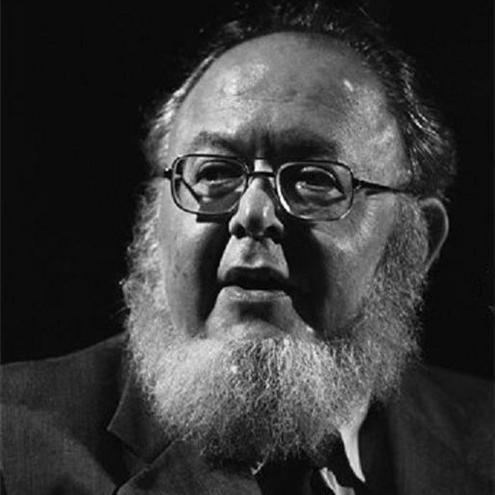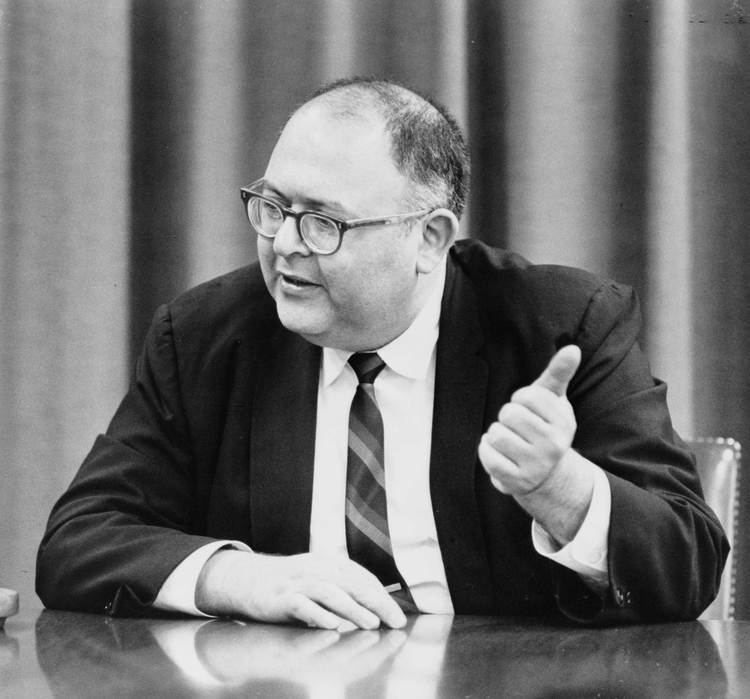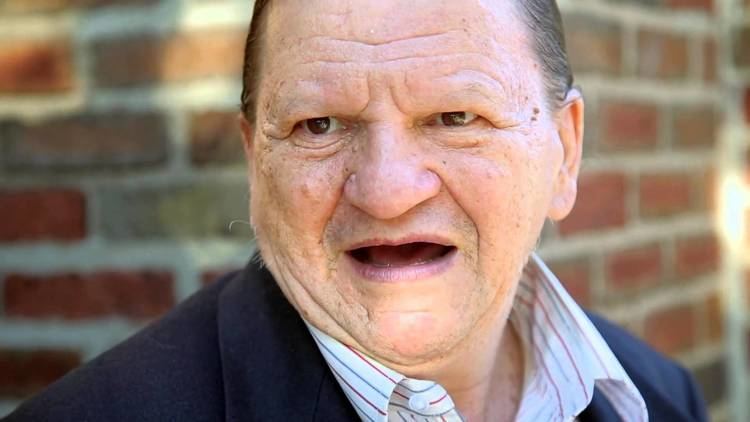Name Herman Kahn | Role Strategist | |
 | ||
Alma mater University of California, Los Angeles (B.S., Physics)California Institute of Technology (M.S.) Occupation FuturistMilitary strategistSystems theorist Died July 7, 1983, Chappaqua, New Castle, New York, United States Books On Thermonuclear War, On escalation Education University of California, Los Angeles, California Institute of Technology People also search for Julian Simon, Leon Martel, Takeaki Hori | ||
1980 herman kahn looks at america outrageous
Herman Kahn (February 15, 1922 – July 7, 1983) was a founder of the Hudson Institute and one of the preeminent futurists of the latter part of the twentieth century. He originally came to prominence as a military strategist and systems theorist while employed at the RAND Corporation. He became known for analyzing the likely consequences of nuclear war and recommending ways to improve survivability, making him one of three historical inspirations for the title character of Stanley Kubrick's classic black comedy film satire Dr. Strangelove.
Contents
- 1980 herman kahn looks at america outrageous
- Hudson Institute 50th Anniversary Video Tribute
- Background
- Cold War theories
- The unthinkable
- Hudson Institute and Vietnam War
- The Year 2000
- Later years
- Cultural influence
- Publications
- References

His theories contributed heavily to the development of the nuclear strategy of the United States.
Hudson Institute 50th Anniversary Video Tribute
Background

Kahn was born in Bayonne, New Jersey, the son of Yetta (née Koslowsky) and Abraham Kahn, a tailor. His parents were Jewish immigrants from Eastern Europe. He was raised in the Bronx, then in Los Angeles following his parents' divorce. Raised Jewish, he later became an atheist. He attended the University of California, Los Angeles (UCLA), majoring in physics. During World War II, he was stationed by the Army as a telephone linesman in Burma. After the war, he completed his BS degree at UCLA and embarked on a doctorate at Caltech. He dropped out for financial reasons, but did receive an MSc. Following a brief stint in real estate, he joined the RAND Corporation via his friend Samuel Cohen, the inventor of the neutron bomb. He became involved with the development of the hydrogen bomb, commuting to the Lawrence Livermore Laboratory in northern California to work closely with Edward Teller, John von Neumann, Hans Bethe, and Albert Wohlstetter.
Cold War theories

Kahn's major contributions were the several strategies he developed during the Cold War to contemplate "the unthinkable" – namely, nuclear warfare – by using applications of game theory. Kahn is often cited (with Pierre Wack) as a father of scenario planning. During the mid-1950s, the Eisenhower administration's prevailing nuclear strategy had been one of "massive retaliation", enunciated by Secretary of State John Foster Dulles. According to this theory, dubbed the "New Look", the Soviet Army was considerably larger than that of the United States and therefore presented a potential security threat in too many locations for the Americans to counter effectively at once. Consequently, the United States had no choice but to proclaim that its response to any Soviet aggression anywhere would be a nuclear attack.

Kahn considered this theory untenable because it was crude and potentially destabilizing. He argued that New-Look theory invited nuclear attack by providing the Soviet Union with an incentive to precede any conventional localized military action somewhere in the world with a nuclear attack on U.S. bomber bases, thereby eliminating the Americans' nuclear threat immediately and forcing the United States into the land war it sought to avoid.
In 1960, as Cold War tensions were near their peak following the Sputnik crisis and amidst talk of a widening "missile gap" between the United States and the Soviet Union, Kahn published On Thermonuclear War, the title of which clearly alluded to On War, the classic 19th-century treatise by the German military strategist Carl von Clausewitz.
Kahn rested his theory upon two premises, one obvious, one highly controversial. First, nuclear war was obviously feasible, since the United States and the Soviet Union currently had massive nuclear arsenals aimed at each other. Second, like any other war, it was winnable.
Kahn argued for deterrence and believed that if the Soviet Union believed that the United States had a second strike capability then it would offer greater deterrence, which he wrote in his paper titled "The Nature and Feasibility of War and Deterrence".
Whether hundreds of millions died or "merely" a few major cities were destroyed, Kahn argued, life would go on – as it had, for instance, after the Black Death in Europe during the 14th century, or in Japan after the limited nuclear attack in 1945 – contrary to the conventional, prevailing doomsday scenarios. Various outcomes might be far more horrible than anything hitherto witnessed or imagined, but some of them nonetheless could be far worse than others. No matter how calamitous the devastation, Kahn argued that the survivors ultimately would not "envy the dead" and to believe otherwise would mean that deterrence was unnecessary in the first place. If Americans were unwilling to accept the consequences, no matter how horrifying, of a nuclear exchange, then they certainly had no business proclaiming their willingness to attack. Without an unfettered, unambivalent willingness to "push the button", the entire array of preparations and military deployments was merely an elaborate bluff.
The bases of his work were systems theory and game theory as applied to economics and military strategy. Kahn argued that for deterrence to succeed, the Soviet Union had to be convinced that the United States had second-strike capability in order to leave the Politburo in no doubt that even a perfectly coordinated massive attack would guarantee a measure of retaliation that would leave them devastated as well:
At the minimum, an adequate deterrent for the United States must provide an objective basis for a Soviet calculation that would persuade them that, no matter how skillful or ingenious they were, an attack on the United States would lead to a very high risk if not certainty of large-scale destruction to Soviet civil society and military forces.
Superficially, this reasoning resembles the older doctrine of Mutual Assured Destruction (MAD) due to John von Neumann, although Kahn was one of its vocal critics. Strong conventional forces were also a key element in Kahn's strategic thinking, for he argued that the tension generated by relatively minor flashpoints worldwide could be dissipated without resort to the nuclear option.
"The unthinkable"
Due to his willingness to articulate the most brutal possibilities, Kahn came to be disliked by some, although he was known as amiable in private, especially around children. Unlike most strategists, he was entirely willing to posit the form a post-nuclear world might assume. Fallout, for example, would simply be another one of life's many unpleasantnesses and inconveniences, while the "much-ballyhooed" rise in birth defects would not doom mankind to extinction because a majority of survivors would remain unaffected by them. Contaminated food could be designated for consumption by the elderly, who would presumably die before the delayed onset of cancers caused by radioactivity. A degree of even modest preparation – namely, the fallout shelters, evacuation scenarios and civil defense drills now seen as emblematic of the "Cold War" – would give the population both the incentive and the encouragement to rebuild. He even recommended the government offer homeowners insurance against nuclear-bomb damage. Kahn felt that having a strong civil-defense program in place would serve as an additional deterrent, because it would hamper the other side's potential to inflict destruction and thus lessen the attraction of the nuclear option. A willingness to tolerate such possibilities, Kahn argued, might be worth sparing Europe the massive nuclear exchange more likely to occur under the pre-MAD doctrine.
A number of pacifists, including A.J. Muste and Bertrand Russell, admired and praised Kahn's work because they felt it presented a strong case for full disarmament by suggesting that nuclear war was all but unavoidable. Others criticized Kahn vehemently, claiming that his postulating the notion of a "winnable" nuclear war made such a war – whether judged subsequently as "won", "lost", or neither – more likely.
Hudson Institute and Vietnam War
In 1961, Kahn, Max Singer and Oscar Ruebhausen founded the Hudson Institute, a policy research organization initially located in Croton-on-Hudson, New York, where Kahn was living at the time. Luminaries such as sociologist Daniel Bell, political philosopher Raymond Aron and novelist Ralph Ellison (author of the 1952 classic Invisible Man) were recruited.
Stung by the vociferousness of his critics, Kahn somewhat softened his tone and responded to their points in Thinking About the Unthinkable (1962) and On Escalation (1965). Between 1966 and 1968, during the peak of the Vietnam War, Kahn served as a consultant to the Department of Defense and opposed the growing pressure to negotiate directly with North Vietnam, arguing that the only military solution was sharp escalation. Failing that, he said, the U.S. government needed an exit strategy. He claimed credit for introducing the term "Vietnamization".
Kahn and the Hudson Institute advised against starting a counterinsurgency war in Vietnam, but, once it had begun, they gave advice on how to wage it. In an interview, he said that he and the Institute preferred not to give advice to (for example) the Secretary of Defense, because disagreement at such a high level might be regarded as treason, whereas disagreement with, say, the Deputy Undersecretary was regarded as no more than technical. As regards a plan, British advisers, with experience from the Commonwealth's successful counterinsurgency war in Malaya, were consulted. Kahn and the Institute, however, judged that a crucial difference between the Vietnemese and Malayan situations was the British rural constabulary in Malaya. An Institute study of the major counterinsurgency wars in recent history found a 100% correlation between successful wars and effective police forces. Kahn said "...the purpose of an army is to protect your police force. We had an army in Vietnam without a purpose."
The Year 2000
In 1967, Herman Kahn and Anthony J. Wiener published The Year 2000: A Framework for Speculation on the Next Thirty-Three Years, which included contributions from staff members of the Hudson Institute and an introduction by Daniel Bell. Table XVIII in the document contains a list called "One Hundred Technical Innovations Very Likely in the Last Third of the Twentieth Century". The first ten predictions were:
- Multiple applications of lasers.
- Extreme high-strength structural materials.
- New or improved superperformance fabrics.
- New or improved materials for equipment and appliances.
- New airborne vehicles (ground-effect vehicles, giant or supersonic jets, VTOL, STOL).
- Extensive commercial applications of shaped-charge explosives.
- More reliable and longer-range weather forecasting.
- Extensive and/or intensive expansion of tropical agriculture and forestry.
- New sources of power for fixed installations.
- New sources of power for ground transportation.
Later years
With the easing of nuclear tensions during the détente years of the 1970s, Kahn continued his work on futurism and speculations about the potential for Armageddon. He and the Hudson Institute sought to refute popular essays such as Paul Ehrlich's "The Population Bomb" (1968), Garrett Hardin's similarly reasoned "The Tragedy of the Commons" (also 1968) and the Club of Rome's "Limits to Growth" (1972). In Kahn's view, capitalism and technology held nearly boundless potential for progress, while the colonization of space lay in the near, not the distant, future. Kahn's 1976 book The Next 200 Years, written with William Brown and Leon Martel, presented an optimistic scenario of economic conditions in the year 2176. He also wrote a number of books extrapolating the future of the American, Japanese and Australian economies and several works on systems theory, including the well-received 1956 monograph Techniques of System Analysis.
During the mid-1970s, when South Korea's GDP per capita was one of the lowest in the world, Kahn predicted that the country would become one of the top 10 most powerful countries in the world by the year 2000.
In his last year, 1983, Kahn wrote approvingly of Ronald Reagan's political agenda in The Coming Boom: Economic, Political, and Social and bluntly derided Jonathan Schell's claims about the long-term effects of nuclear war. On July 7 that year, he died of a stroke, aged 61.
Cultural influence
Along with John von Neumann, Edward Teller and Wernher von Braun, Kahn was, reportedly, an inspiration for the character "Dr. Strangelove" in the eponymous film by Stanley Kubrick released in 1964. It was also said that Kubrick immersed himself in Kahn's book On Thermonuclear War. In the film, Dr. Strangelove refers to a report on the Doomsday Machine by the "BLAND Corporation". Kahn met Kubrick and gave him the idea for the "Doomsday Machine", a device which would immediately cause the destruction of the entire planet in the event of a nuclear attack. Both the name and the concept of the weapon are drawn from the text of On Thermonuclear War. Louis Menand observes, "In Kahn’s book, the Doomsday Machine is an example of the sort of deterrent that appeals to the military mind but that is dangerously destabilizing. Since nations are not suicidal, its only use is to threaten."
Walter Matthau's maverick character "Professor Groeteschele" in the film Fail-Safe, also released in 1964, is also based on Kahn. (In this film, the U.S. President tries to prevent a nuclear holocaust when a mechanical malfunction sends nuclear weapons toward Moscow.)
In The Politics of Ecstasy, Timothy Leary suggests that Kahn had taken LSD.
Publications
Outside physics and statistics, works written by Kahn include:
Works published by the RAND Corporation involving Kahn:
